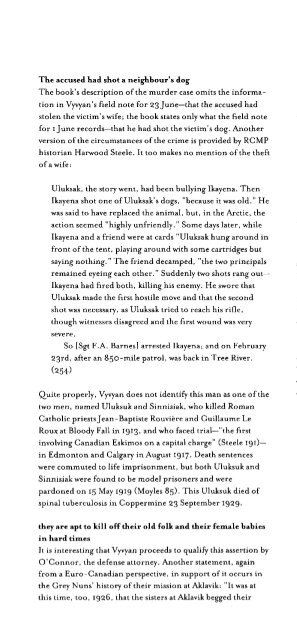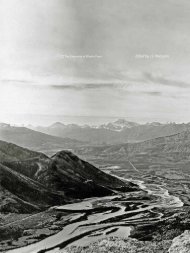C Ihe Ladies c cu. V'VVAN - History and Classics, Department of
C Ihe Ladies c cu. V'VVAN - History and Classics, Department of
C Ihe Ladies c cu. V'VVAN - History and Classics, Department of
- No tags were found...
You also want an ePaper? Increase the reach of your titles
YUMPU automatically turns print PDFs into web optimized ePapers that Google loves.
Notes to Page 58 261The ac<strong>cu</strong>sed had shot a neighbour's dogThe book's description <strong>of</strong> the murder case omits the informationin Vyvyan's field note for 23 June-that the ac<strong>cu</strong>sed hadstolen the victim's wife; the book states only what the field notefor IJune records-that he had shot the victim's dog. Anotherversion <strong>of</strong> the cir<strong>cu</strong>mstances <strong>of</strong> the crime is provided by RCMPhistorian Harwood Steele. It too makes no mention <strong>of</strong> the theft<strong>of</strong>awife:Uluksak, the story went, had been bullying lkayena. Thenlkayena shot one <strong>of</strong>Uluksak's dogs, "because it was old." Hewas said to have replaced the animal. but, in the Arctic, theaction seemed "highly unfriendly." Some days later, whileIkayena <strong>and</strong> a friend were at cards "Uluksak hung around infront <strong>of</strong> the tent, playing around with some cartridges butsaying nothing." The friend decamped, "the two principalsremained eyeing each other." Suddenly two shots rang outlkayenahad fired both, killing his enemy. He swore thatUluksak made the first hostile move <strong>and</strong> that the secondshot was necessary, as Uluksak tried to reach his rifle,though witnesses disagreed <strong>and</strong> the first wound was verysevere.So [Sgt F.A. Barnes] arrested lkayena; <strong>and</strong> on February23rd, after an 850-mile patrol, was back in Tree River.(254)Quite properly, Vyvyan does not identify this man as one <strong>of</strong> thetwo men, named Uluksuk <strong>and</strong> Sinnisiak, who killed RomanCatholic priestsJean-Baptiste Rouviere <strong>and</strong> Guillaume LeRoux at Bloody Fall in 1913, <strong>and</strong> who faced trial-"the firstinvolving Canadian Eskimos on a capital charge" (Steele 191)in Edmonton <strong>and</strong> Calgary in August 1917. Death sentenceswere commuted to life imprisonment, but both Uluksuk <strong>and</strong>Sinnisiak were found to be model prisoners <strong>and</strong> werepardoned on IS May 1919 (Moyles 85). This Uluksuk died <strong>of</strong>spinal tuber<strong>cu</strong>losis in Coppermine 23 September 1929.they are apt to kill <strong>of</strong>f their old folk <strong>and</strong> their feIIlale babiesin hard tiIIlesIt is interesting that Vyvyan proceeds to qualify this assertion byO'Connor, the defense attorney. Another statement, againfrom a Euro-Canadian perspective, in support <strong>of</strong> it oc<strong>cu</strong>rs inthe Grey Nuns' history <strong>of</strong> their mission at Aklavik: "It was atthis time, too, 1926, that the sisters at Aklavik begged theirSuperior <strong>and</strong> the Canadian government to open a 'creche' fornew-born babies. Their reason was that baby girls were eithercrushed to death or left in the wilds to be devoured by bears orwolves. Their cause was well received" (Champagne). Differentperspectives are <strong>of</strong>fered by both the biographer <strong>and</strong> the wife <strong>of</strong>the then governor general <strong>of</strong> Canada. Julian HedworthGeorge, Viscount Byng <strong>of</strong> Vi my travelled down the Mackenziein 1925 <strong>and</strong>, thanks to arrangements made at the last minute byCanon Edward Hester, met Inuvialuit at Kittigazuit: "One <strong>of</strong>[their] more endearing qualities," thought Byng, "was theirobvious fondness for children-their name for them was'noogiduks''' (Williams 299). Although she had travelled withhim to the Yukon on an earlier trip, Lady Byngwas advisedagainst the Mackenzie River trip, "which was supposed to be toorough for me, though I shall always regret I didn't insist ongOing." She records her husb<strong>and</strong>'s impression <strong>of</strong> the Inuit viewthus: "So long as a baby was a helpless piece <strong>of</strong> humanity it waseverybody's job to help it, but the moment it was old enough totwist a rope, or do any work, it took its place in the scheme <strong>of</strong>things" (Byng 159). It is impossible to know if, without theopportunity <strong>of</strong> making her own observations, she might havedetected a discrepancy in the treatment <strong>of</strong> boys <strong>and</strong> girls.A somewhat more conclusive view <strong>of</strong> Inuit treatment <strong>of</strong> theelderly, nearly contemporary (1928) with the view heard byVyvyan, is that <strong>of</strong> Anglican Archdeacon Archibald Fleming,who worked extensively with Inuit in both the eastern <strong>and</strong>western Arctic:From time immemorial the Eskimo had from sheereconomic necessity but one solution to the problem <strong>of</strong> theaged <strong>and</strong> helpless: to wall them <strong>of</strong>f during the cold <strong>of</strong> thewinter into an igloo where death came quietly <strong>and</strong> alone.To us this seems cruel <strong>and</strong> terrible but in a l<strong>and</strong> whereconstant traveling is essential <strong>and</strong> where hunger stalks eachliving thing, the burden <strong>of</strong> the h<strong>and</strong>icapped makes animpossible dem<strong>and</strong>. During the last thirty years [presumably,thirty years prior to 1956, the date <strong>of</strong> publication <strong>of</strong>Fleming's book] conditions in the Arctic have so changedthat this problem, the pity <strong>of</strong> which lay on my heart likelead, has been largely solved. I think it is safe to say that noEskimo or Indian now needs to feel the death knell tollingwhen he has had an accident or exceeds the normal span <strong>of</strong>life. (294)
















